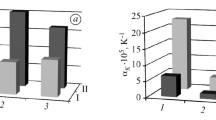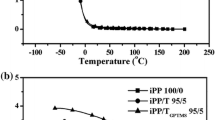By using the modular-deformation method of calculations, we established the influence of finely divided filler (talc) and additional heat treatment on the elastoplastic properties of polylactide materials. We detected the changes in the modulus of deformation, elasticity modulus, and thermomechanical characteristics of polylactide composites. The maximum values of the moduli and melting point were observed for thermally treated specimens with a talc content of 2 wt.%. We determined the fractions of the elastic, plastic, and highly elastic components in the total deformation of polylactide materials and showed that the fraction of the plastic component decreases after thermal treatment and as a result of introduction of the filler. It was also discovered that the level of hardness and structure factor of the obtained materials noticeably increase as a result of the introduction of talc and additional thermal treatment.




Similar content being viewed by others
References
Y.-W. Mai and Z.-Z. Yu (editors), Polymer Nanocomposites, CRC Press, Boca Raton (2006).
V. K. Thakur, M. K. Thakur, and A. Pappu (editors), Hybrid Polymer Composite Materials, Woodhead Publ., Cambridge (2017).
M. Niaounakis, Biopolymers: Applications and Trends, William Andrew, Oxford (2015).
Y. Tokiwa and B. P. Calabia, “Biodegradability and biodegradation of poly(lactide),” Appl. Microbiol. Biotechnol., 72, 244–251 (2006).
L. T. Sin and S. T. Bee, Polylactic Acid: A Practical Guide for the Processing, Manufacturing, and Applications of PLA, William Andrew, Oxford (2019).
M. L. Di Lorenzo and R. Androsch (editors), Industrial Applications of Poly(lactic acid), Springer, Cham (2018).
M. Murariu and P. Dubois, “PLA composites: From production to properties,” Adv. Drug Deliv. Rev., 107, 17–46 (2016).
F. Carrasco, P. Pagès, J. Gámez-Pérez, O. O. Santana, and M. L. Maspoch, “Processing of poly(lactic acid): Characterization of chemical structure, thermal stability, and mechanical properties,” Polymer. Degrad. Stabil., 95, 116–125 (2010).
V. Levyts’kyi, А. Masyuk, Т. Bialopiotrowicz, L. Bilyi, and T. Humenets’kyi, “Morphology and properties of thermoplastic composites with modified silicate fillers,” Fiz.-Khim. Mekh. Mater., 54, No. 1, 53–58 (2018); English translation: Mater. Sci., 54, No. 1, 48–54 (2018).
V. Levytskyj, Y. Laruk, T. Humenetsky, and J. Sikora, “The influence of polystyrene modifier and plasticizer nature on the properties of poly(vinyl chloride),” Chem. Chem. Technol., 9, No. 2, 199–203 (2015).
É. Kh. Liiv and A. D. Mashegirov, Procedure of Determination of the Physicomechanical Properties of Polymeric Composites by Indentation with a Conic Indenter [in Russian], Vol. 27, ÉstNIINTI, Tallinn (1983).
V. E. Levyts’kyi, А. S. Masyuk, D. S. Samoilyuk, L. М. Bilyi, and Т. V. Humenets’kyi, “Morphology and properties of polymer–silicate composites,” Fiz.-Khim. Mekh. Mater., 52, No. 1, 21–27 (2016); English translation: Mater. Sci., 52, No. 1, 17–24 (2016).
L. M. Lebedev, Machines and Instruments for Testing Polymers [in Russian], Mashinostroenie, Moscow (1967).
A. Jiménez, M. Peltzer, and R. Ruseckaite (editors), Poly(lactic acid) Science and Technology: Processing, Properties, Additives, and Applications, Royal Society of Chemistry, Cambridge (2014).
V. Levytsky, V. Kochubei, and A. Gancho, “Influence of the silicate modifier nature on the structure and properties of polycaproamide,” Chem. Chem. Technol., 7, No. 2, 169–173 (2013).
V. E. Levyts’kyi, D. S. Katruk, A. M. Shybanova, L. M. Bilyi, and T. V. Humenets’kyi, “Physicochemical properties of modified polyester-polyvinylchloride compositions,” Fiz.-Khim. Mekh. Mater., 52, No. 4, 100–105 (2016); English translation: Mater. Sci., 52, No. 4, 559–565 (2016).
K. Hamada, M. Kaseemb, M. Ayyoobd, J. Jooa, and F. Deric, “Polylactic acid blends: The future of green, light, and tough,” Progr. Polymer. Sci., 85, 83–127 (2018).
V. Levytskyi, A. Masyuk, and O. Suberlyak, “Preparation and properties of polymer-silicate composites based on hydrophilic polymers,” Vopr. Khim. Khim. Tekhnol., No. 6, 68–74 (2017).
Author information
Authors and Affiliations
Corresponding author
Additional information
Translated from Fizyko-Khimichna Mekhanika Materialiv, Vol. 56, No. 3, pp. 31–38, May–June, 2020.
Rights and permissions
About this article
Cite this article
Masyuk, А.S., Kysil, K.V., Katruk, D.S. et al. Elastoplastic Properties of Polylactide Composites with Finely Divided Fillers. Mater Sci 56, 319–326 (2020). https://doi.org/10.1007/s11003-020-00432-y
Received:
Published:
Issue Date:
DOI: https://doi.org/10.1007/s11003-020-00432-y




